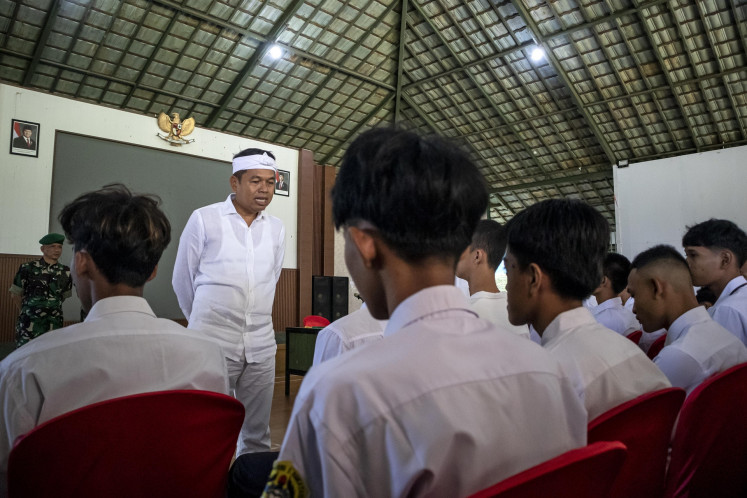In cursed forest, woman liberates herself
Siwa (Whanny Darmawan, center) disguises as a cow shepherd to test his wife Uma (Rachel Saraswati, right)Teater Garasi rejuvenates a Javanese myth about love, sacrifice and atonement
Change text size
Gift Premium Articles
to Anyone

Siwa (Whanny Darmawan, center) disguises as a cow shepherd to test his wife Uma (Rachel Saraswati, right)
Teater Garasi rejuvenates a Javanese myth about love, sacrifice and atonement.
Men like to think that they can overpower women as part of their conquests. Even Shiva, the most powerful god in Hinduism, is so insecure that he needs to test the fidelity of his wife, Uma, also known as Parvati.
In the Sudamala romance from the Mahabharata epic, Shiva pretends to get sick and asks Uma to find milk from a white cow to cure him. Uma finally gets it, but in a trade for having an affair with the shepherd, who is actually Shiva in disguise.
After falling victim to his own dirty trick, Shiva banishes Uma from heaven, cursing her by transforming her into a giant demon named Durga. He locks her in a horrible forest, Gandamayu, which houses plagues and smells like the dead. 
In the absence of downbeat and slow-paced traditional Javanese dance, the performance, titled Gandamayu Repertoire, featured the powerful rock vocals of singer Ayu Laksmi (as Kalika) and vigorous moves from dancers that commanded the flow and mood of each scene.
The costumes evinced a Victorian sensibility, presenting the play’s lead actresses in ball gowns and the actors in vest and ties. The stage was designed to encompass the anachronisms of the source material - from a walk in the woods to Kurusetra, the battlefield of Bharatayudha.
The play opens with a conversation between a father (Landung Simatupang) and his daughter (Arsita Iswardhani) during their journey through the village in the present day. The father is a Balinese singer who is often invited to traditional ceremonial events in villages.
While leading his bicycle, he tells his daughter the story of Sudamala, a handsome warrior who rescued Uma from the curse of Shiva. The father and daughter appear between scenes to narrate the story.
The focus then shifts to Uma (Rachel Saraswati), clad in a stark yellow gown, worrying about the ailing Shiva, or Siwa (Whanny Darmawan), who appears on stage in a hospital bed complete with an IV bottle.
The hospital bed, which represents Uma’s lovesickness and her despair, remains on stage throughout the performance. Subsequent action flows around it.
Siwa curses Uma into Durga (Ine Febriyanti) for her affair and exiled to Gandamayu with loyal company Kalika, another goddess who was cursed and transformed into a giant for murdering her unfaithful husband and accidentally killing dozens of other men during her revenge.
“Is there any exact measurement of fidelity? And what is the meaning of loyalty after I have given my whole world to him?” asks Durga, mixing resentment and anger.
Siwa tells Durga that she can only return if she redeems her sin by a cleansing ritual (ruwat) performed by Sahadewa, the youngest of Pandava brothers, later known as Sudamala. 
The novel, which tells of multiple quests on heaven and earth and one great war, is not easily adapted into a ninety-minute play. The fluid stage design and the contemporary feel were the work of directors Yudi Ahmad Tajudin, who was also artistic director, and Gunawan Maryanto, who also adapted the novel for the stage.
The Kurusetra battle was visualized with a collective dance and an upbeat score. The dancers, dressed in jodhpur pants and checkered vests, performed energetic and entertaining zombie dances that described the mood of the scenes.
The possessed Kunti (Harbani Setyowati Wibowo), who under the spell of Kalika takes Sahadewa to Gandamayu, is depicted with Kalika dancing behind Kunti.
The cleansing ritual for Durga, in which Siwa enters the body of Sahadewa (Theodorus Christanto) is symbolized by the two men exchanging coats.
“We seriously worked on the visualization of the play right after Gunawan Maryanto finished adapting the novel into script. We tried to interpret the play for the stage,” said Yudi.
Whanny’s dominating voice and vibrant acting along with Harbani’s mournful and powerful voice gave weight to the play, while Kalika’s robotic and awkward body movements, indicating that she’s a giant despite her white ball gown and beautiful make-up, drew some laughter from the audience.
Traditional traces were not totally expunged. Ayu’s trembling movements to signify that Kalika is a giant are common in Balinese dance, while Ine glares, leers and puts on a gruff voice during the play to enliven Durga.
The ambition to leave behind the traditional Javanese epic was seen in the ending of the play, which is different from the novel and the epic.
The play ends with Uma breaking free from Siwa while saying, “let Siwa wait for me,” while in the novel Uma returns to heaven with Siwa.
“As Durga, I am very angry with Siwa. He is such a coward. If he wants to measure my loyalty, he should not pretend like that. Durga is treated very unfairly,” Ine said after rehearsal on Monday.
A remark from Durga concludes what she feels about Siwa.
“Do you still deserve my love after you have humiliated Uma in such a way?”
— Photos by R. Berto Wedhatama









